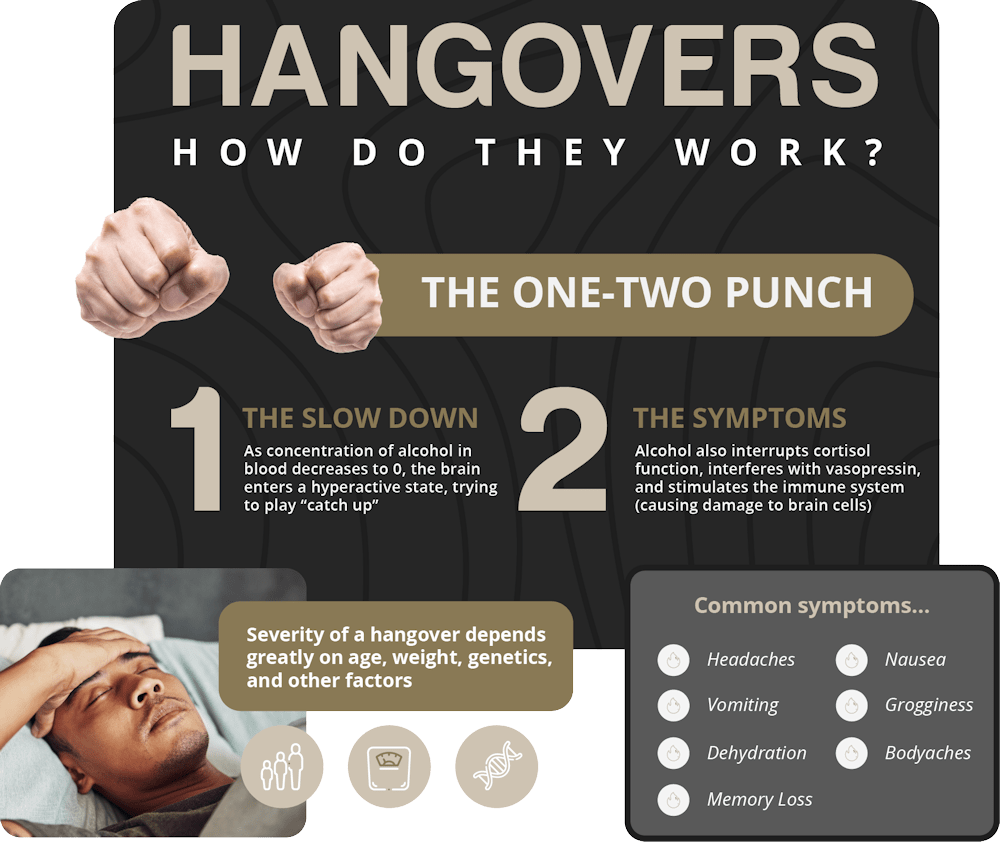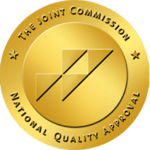A hangover is a group of undesirable and uncomfortable signs and symptoms that may develop after drinking too much over time. Generally, the more alcohol you consume, the higher your likelihood of having a hangover the next day. However, there’s no way to know exactly how much you can safely drink and still avoid a hangover.
What Causes a Hangover?
The short answer is that hangovers are caused by drinking too much alcohol. Unfortunately, a single alcoholic drink may be enough to trigger a hangover for some individuals, while others may drink heavily and get away without getting a hangover at all. Before we can answer “What is a hangover?” let’s look at the many factors that may contribute to a hangover.
Alcohol Consumption Causes Your Body to Produce More Urine
This causes you to urinate more often and can lead to dehydration. Thirst, dizziness, and lightheadedness are often indications of dehydration, just one of a number of causes of a hangover.
Alcohol Brings About an Inflammatory Reaction From Your Immune System
Your immune system may trigger certain agents that usually produce physical symptoms such as:
- Trouble concentrating
- Memory problems
- Decreased appetite
- Loss of interest in usual activities
Alcohol Irritates Your Stomach Lining
Alcohol heightens the production of stomach acid and delays the emptying of the stomach. These factors can result in:
- Abdominal pain
- Nausea
- Vomiting
Alcohol Can Make Your Blood Sugar Drop
If your blood sugar becomes too low, you may experience:
- Fatigue
- Shakiness
- Weakness
- Mood disturbances
- Seizures
Alcohol Causes Your Blood Vessels to Expand
This can cause headaches.
Alcohol Can Make You Feel Sleepy
However, it prevents the deeper stages of sleep and frequently causes a person to wake up in the middle of the night. This leaves them feeling groggy and tired.
The Congener Factor
Congeners are ingredients in alcoholic beverages that give flavor to many types of alcohol and can contribute to hangovers. They are found in larger amounts of dark liquors like brandy or bourbon than in clear liquors such as gin and vodka. Congeners are more likely to cause a hangover or increase the severity of a hangover. Still, drinking too much of any color of alcohol can make you feel a hangover the next morning.
5 Hangover Risk Factors
As mentioned, anyone can experience a hangover. But some individuals are more likely to have a hangover than others. A genetic variation that affects the way alcohol is processed in the body may cause some people to flush, sweat, or be sick after drinking a small amount of alcohol. For most people, factors that make a hangover more likely or more severe include:
Drinking on an Empty Stomach
Having an empty stomach speeds the absorption of alcohol by your body.
Using Other Drugs, Such as Nicotine, Along With Alcohol
Combining smoking with drinking seems to increase the likelihood of a hangover.
Not Sleeping Well or for a Long Enough Time After Drinking
Many researchers believe that some hangover symptoms are in some part due to the poor quality and short duration of the sleep cycle that typically follows a night of drinking.
A Family History of Alcoholism
If you have close relatives with a history of alcoholism, it may suggest an inherited problem with the way your body processes alcohol.
Drinking Darker-Colored Alcoholic Beverages
Drinks that are darker colored frequently contain a higher volume of congeners and may be more likely to cause a hangover.
Typical Hangover Symptoms
It may feel neverending, but most hangovers go away on their own within 24 hours. Hangover symptoms usually begin when your blood alcohol content drops substantially and is at or near zero. They usually reach their full effect the morning after a night of heavy drinking. Depending on what and how much you drink, you will probably notice these symptoms:
- Weakness and fatigue
- Dry mouth and excessive thirst
- Head and muscle aches
- Nausea, vomiting, or stomach pain
- Sleep problems
- Increased light and sound sensitivity
- A sense of the room spinning or dizziness
- Trouble concentrating
- Mood issues like depression, anxiety, and irritability
- Shakiness
- Rapid heartbeat
Complications
When you’re hungover, you will probably have memory, dexterity, and concentration problems. This temporary dulling of your abilities increases the risk of:
- Absenteeism
- Trouble completing assignments
- Conflict with others
- Sleeping on the job or at school
- Injury at work
Hangovers from a single night’s drinking go away on their own. However, you should talk to a medical professional if you’re concerned that frequent heavy drinking can lead to serious alcohol withdrawal. Also, if regular hangovers are affecting your quality of life, including personal relationships or work performance.
What’s the Difference Between a Hangover and Withdrawal?
Many people wonder “Is a hangover alcohol withdrawal?” No. Alcohol withdrawal is a condition that happens to a person who drinks regularly and then stops.
It shouldn’t be confused with a hangover, which can happen to people who drink casually on occasion. Alcohol withdrawal happens when a chronic drinker suddenly cuts down their consumption of alcohol or stops completely. On the other hand, you can experience a hangover whether you’re an alcoholic or a light drinker after heavy consumption of alcohol.
How Much Is Too Much?
If you believe you might have experienced alcohol withdrawal, you may wonder where you are on the spectrum of light, moderate, or heavy drinking. “Too much” depends on an individual’s sex, age, and weight but there are a few general rules.
Heavy Drinking
According to the Centers for Disease Control and Prevention (CDC), you are considered a heavy drinker if:
- Your sex is female at birth and you drink more than 7 drinks per week or more than 3 drinks per occasion
- Your sex is male at birth and you drink more than 14 drinks per week or more than 4 drinks per occasion.
- Your age is 65 or older and drinks more than 7 drinks per week or more than 3 drinks per occasion.
Moderate Drinking
On average for the past year:
- More than 3 drinks but no more than 7 drinks per week for women
- More than 3 drinks but no more than 14 drinks per week for men
Light Drinking
- At least 12 drinks in the past year, but 3 or fewer drinks per week on average for the past year.
Alcohol Poisoning
There are more severe symptoms that accompany heavy drinking that may point to alcohol poisoning which is a life-threatening emergency. You should call 911 if a person is showing signs of:
- Confusion
- Vomiting
- Seizures
- Slow breathing (less than 8 breaths/minute)
- Irregular breathing (a gap of more than 10 seconds between breaths)
- Pale or blue-tinged skin
- Low body temperature
- Problems staying conscious
- Becoming unconscious and can’t be awakened
An individual who is unconscious or can’t be awakened is at risk of dying. If you think that someone has alcohol poisoning, even if the symptoms aren’t obvious, get immediate medical care.
Alcohol Withdrawal
When we constantly expose our brains to alcohol, they adjust to make up for the effects of the drug. When the alcohol leaves our body, the brain continues to make up for the drug even though it’s gone. After a while, the overstimulation of our brain leads to what is known as alcohol withdrawal.
Quick Facts About Alcohol Withdrawal
- Over 200,000 Americans suffer from alcohol withdrawal annually
- Signs of alcohol withdrawal can start after 2 hours to 4 days
- Symptoms of withdrawal range in severity from mild to life-threatening
- Mild symptoms can begin within 6 hours of not drinking
- Individuals who have consumed heavy amounts of alcohol for years may experience more severe withdrawal symptoms
- Severe symptoms may appear within 12 to 24 hours (hallucinations) or 2 days (seizures)
- Moderate drinkers–males who drink 2 drinks or less per day or females who drink 1 drink or less per day aren’t likely to experience withdrawal symptoms if they stop drinking.
- Alcohol withdrawal syndrome (AWS) usually affects people who are chronic heavy drinkers.
- An individual who has experienced alcohol withdrawal once is more likely to experience it again, even if they have become moderate drinkers.
Symptoms of PAWS
Since we know what alcohol withdrawal is, what are the symptoms? Remember, hangovers are not the same as alcohol withdrawal although some of the symptoms may be similar. Symptoms will vary per person but can include:
- Anxiety
- Elevated blood pressure
- Shaky hands
- Headache
- Fatigue
- Nausea and vomiting
- Irritability
- Sweating
- Insomnia
An uncommon but severe symptom of PAWS is delirium tremens (DTs). About 55 of people who attempt to quit alcohol experience delirium tremens. DT usually begins 48 to 72 hours after stopping alcohol.
Withdrawal Timeline
After an individual stops consuming alcohol:
- Withdrawal symptoms begin within about 6 hours of the person’s last drink.
- After about 12 hours, they may start sweating, feeling nauseous, or becoming irritable. The body can tremor, as their heart rate and blood pressure rise.
- After about 12 hours, most people will experience insomnia.
At the 24 to 48-hour mark:
- Seizures
- Hallucinations
- DTs may be experienced. This is why quitting without medical supervision is not recommended. As time passes, the condition gets worse.
Between the 3rd and 5th days of withdrawal:
- DTs may continue
- Emotional distress continues
Fortunately, the withdrawal cycle only lasts about a week and begins to decrease after about 5 days. However, recovering from psychological symptoms of addiction can take weeks or months to ease off, such as:
- Anxiety
- Irritability
- Insomnia
PAWS Treatment
If you believe you’re struggling with alcohol use disorder, you are probably interested in detoxing. But don’t make the mistake of diagnosing yourself or trying to detox alone. The safest and best way to recover from alcohol addiction is by getting medical help from professionals who are experienced in addiction recovery.
Detox
A medically supervised detox in a detox center may be necessary depending on the severity of the withdrawal symptoms. During a medically assisted treatment (MAT) patients take medications like Naltrexone to lessen the discomfort.
In the United States, almost 15 million people aged 12 and up are struggling with an alcohol use disorder. Sadly, treating the symptoms of withdrawal is only a short-term solution. It’s necessary to get to the root cause of the problem that caused the substance abuse to begin with.
AUD Treatment
After detoxing, it’s important to continue with treatment. Compared to people who continued to receive treatment after detoxing, those who didn’t were less likely to achieve a 3-year remission and were, therefore, more likely to relapse.
Counseling and Group Therapy
Accredited addiction treatment centers typically offer treatment such as:
- Individual counseling
- Group therapy
- Family therapy program
- Trauma therapy program
Medical Supervision
Professional treatment centers supervise patients to protect their safety. Vital signs, as well as blood pressure, are closely monitored.
The Best Professional Treatment at Westwind Recovery®
Are you struggling with alcohol abuse? Is it someone you care about? Watching a life circle the drain of alcohol use disorder is a painful and depressing way to live.
But it doesn’t have to be like that. Westwind Recovery® in Los Angeles, CA can provide comprehensive treatment for you or your loved one. We have a range of treatment programs, from a supervised detox to a sober living program.
Wherever you or your loved one falls on the spectrum of needs, we can provide an individualized program to help give you the best chance at long-term recovery.
Voted as one of “America’s Best Treatment Centers” in 2020 and 2021, you owe it to yourself to find out what we’re all about and what we have to offer you. We have people, real people, available to answer your questions, and we’re sure you have plenty. We know addiction wasn’t what you had planned for your life so contact us today and let’s talk about how Westwind can help you get back on track.

Dr. Deena is the Chief Clinical Officer of Westwind Recovery®, an award-winning outpatient treatment center in Los Angeles where she oversees the clinical and administrative program and treatment methods. Dr. Deena is a doctor of psychology and licensed clinical social worker since 1993. LCSW #20628. Originally from the East Coast, Dr. Deena has worked running treatment centers, worked as a therapist in psychiatric hospitals as well as school settings and currently has a thriving private practice in the LA area. Dr. Deena has appeared regularly on the Dr. Phil Show as an expert since 2003. She has also been featured on many other TV shows, podcasts and has contributed to written publications as well as podcasts.





